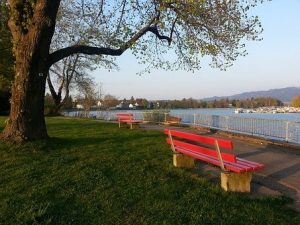Written by Joyce Smith, BS. Individuals living in greener residential neighborhoods may be less likely to develop heart disease and stroke than those living in areas with fewer parks or green spaces.
 Substantial evidence supports the notion that cardiovascular disease risk is affected by many aspects of our residential environment, such as location and characteristics of residential communities, their proximity to major roadways, the availability to walk safely in the neighborhood and access to healthy food 1. However, the impact on the health of residents living in neighborhoods where green spaces are prevalent has been overlooked. Several recent studies have shown that individuals living in areas with more abundant greenery experience fewer depressive symptoms and claim greater satisfaction with their neighborhood, improved social interactions 2 and higher levels of social support 3. Other studies have attributed health benefits including better heart health 4, as decreased mortality from cardiovascular and respiratory diseases 5 and a substantial reduction in levels of mental stress for those living in greener areas 6.
Substantial evidence supports the notion that cardiovascular disease risk is affected by many aspects of our residential environment, such as location and characteristics of residential communities, their proximity to major roadways, the availability to walk safely in the neighborhood and access to healthy food 1. However, the impact on the health of residents living in neighborhoods where green spaces are prevalent has been overlooked. Several recent studies have shown that individuals living in areas with more abundant greenery experience fewer depressive symptoms and claim greater satisfaction with their neighborhood, improved social interactions 2 and higher levels of social support 3. Other studies have attributed health benefits including better heart health 4, as decreased mortality from cardiovascular and respiratory diseases 5 and a substantial reduction in levels of mental stress for those living in greener areas 6.
A current study by the Yeager research team explored a potential association between residential exposure to green spaces and cardiovascular disease (CVD) 7. Utilizing 408 recruited participants with moderate-to-severe CVD risk, the team evaluated potential pathophysiological links between neighborhood greenness and urinary levels of catecholamines and their metabolites along with other biomarkers of CVD risk. (According to previous studies, urinary catecholamine levels are a direct measure of mental stress 8). Also at the time of enrollment researchers quantified the level of residential greenness for every participant.
Using the Geographic Information System software they calculated contemporaneous NDVI (the satellite-derived normalized difference vegetation index) at geographic residential locations in zones with radiuses of 250 m and 1 km surrounding participants’ residences. Those who lived in greener surroundings had lower levels of sympathetic nervous system activation, oxidative stress, and a better angiogenic profile than those living in less green areas. This relationship was independent of sex, race, age, smoking status, neighborhood deprivation index, statin use, and roadway exposure.
After adjusting for residential clustering and demographic, clinical and environmental variables, the team observed an inverse correlation for contemporaneous NDVI within 250 m of a participant’s residence and urinary levels of epinephrine (−6.9 percent) and F2-isoprostane levels (-9 %; P=0.007) This association remained significant within a 1-km-radius circular zone around the participant’s residence.
Women who were not on beta-blockers and those who had not previously experienced a myocardial infarction had stronger correlations between NDVI and urinary epinephrine. Eleven of the 15 subtypes of circulating angiogenic cells examined were inversely associated (-6.9% to -10.1%), and two were positively associated (48.5% and 37.6%) with contemporaneous NDVI. The team also found green spaces were associated with a better capacity for wound healing and blood vessel repair and a reduction in mental distress.
The study was not able to assess for residual confounders or prove causality. Prospective longitudinal studies to further explore the relationship between greenness in residential areas and potential cardiovascular outcomes are recommended.
Source: Yeager, Ray, Daniel W. Riggs, Natasha DeJarnett, Shweta Srivastava, Pawel Lorkiewicz, Zhengzhi Xie, Tatiana Krivokhizhina et al. “Association between residential greenness and exposure to volatile organic compounds.” Science of The Total Environment 707 (2020): 135435.
© 2018 The Authors. Published on behalf of the American Heart Association, Inc., by Wiley. This is an open access article under the terms of the Creative Commons Attribution-NonCommercial License.
Click here to read the full text study.
Posted August 4, 2020.
Joyce Smith, BS, is a degreed laboratory technologist. She received her bachelor of arts with a major in Chemistry and a minor in Biology from the University of Saskatchewan and her internship through the University of Saskatchewan College of Medicine and the Royal University Hospital in Saskatoon, Saskatchewan. She currently resides in Bloomingdale, IL.
References:
- Bhatnagar A. Environmental Determinants of Cardiovascular Disease. Circulation research. 2017;121(2):162-180.
- Orban E, Sutcliffe R, Dragano N, Jöckel KH, Moebus S. Residential Surrounding Greenness, Self-Rated Health and Interrelations with Aspects of Neighborhood Environment and Social Relations. Journal of urban health : bulletin of the New York Academy of Medicine. 2017;94(2):158-169.
- Fan Y, Das KV, Chen Q. Neighborhood green, social support, physical activity, and stress: assessing the cumulative impact. Health & place. 2011;17(6):1202-1211.
- Mitchell R, Popham F. Effect of exposure to natural environment on health inequalities: an observational population study. Lancet. 2008;372(9650):1655-1660.
- Villeneuve PJ, Jerrett M, Su JG, et al. A cohort study relating urban green space with mortality in Ontario, Canada. Environ Res. 2012;115:51-58.
- Triguero-Mas M, Dadvand P, Cirach M, et al. Natural outdoor environments and mental and physical health: relationships and mechanisms. Environ Int. 2015;77:35-41.
- Yeager R, Riggs DW, DeJarnett N, et al. Association between residential greenness and exposure to volatile organic compounds. The Science of the total environment. 2020;707:135435.
- Axelrod J, Reisine TD. Stress hormones: their interaction and regulation. Science. 1984;224(4648):452-459.
